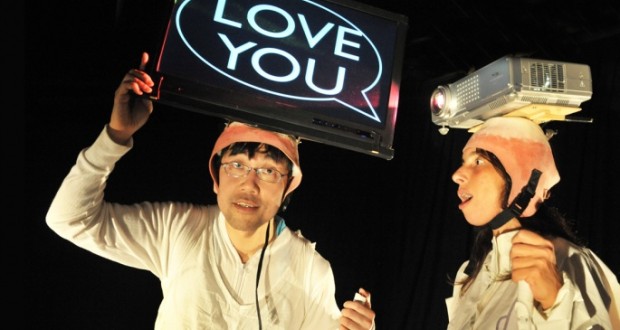Pros: The charming and hilarious effect of an artist conducting a ludicrous show in the most serious of manners.
Cons: The two longish intervals between three short shows, while the installations were being set up. Mamoru Iriguchi’s triple bill at The Place is as strange as it is funny, while his use of technology is remarkable.
Summary
rating
Excellent
As soon as I saw the photo to accompany this show, I knew I was in for a bizarre evening. Mamoru Iriguchi, the lead artist in this triple-bill, is wearing a flat-screen TV on his head, while his partner is bearing a projector, both gadgets fastened tight with elaborate constructions. What I did not know is how much I would enjoy all the strangeness and absurdity. It was charmingly comic and, if this makes sense, silly in a thoughtful way.
Mamoru is a performance artist and theatre designer who is known for his visually quirky, surrealist and humorous work. Attaching a label to this work by defining it exclusively as theatre, installation art, or choreography is impossible; Mamoru cleverly dodges all these descriptive classifications. To get a feel for the production, try and imagine these situations from all three short performances:
In One Man Show, four screens depict a stage from varying angles: every screen is a different theatre seat occupier’s view, watching Mamoru recite the most famous of theatrical lines, Hamlet’s “to be, or not to be”. The “theatregoers”, it turns out, are all versions of Mamoru himself, who abuse his work to be boring and incomprehensible.
Projector/Conjector is a love story between a flat-screen TV and a projector, who embark on a mythical journey to Swanlake Planet, where they conceive, and give birth to, swans. Actual speech is unnecessary, as the couple use the technology at hand to communicate.
GRAFT, which was specially commissioned for the Place’s Spring Loaded 2014 festival, makes superbly clever use of eight laptops spread across the stage, and explores a nightmarish situation in which a spilled coffee cup leads to a black flood and body parts become displaced within the screens.
Does it make good sense? No. But in a magical way, Mamuro manages to draw the audience into his surrealist logic very quickly, so that instead of feeling alienated, I accepted and understood the strange workings of his art.
While an actual storyline can’t really be pinned down, the artist does broadly explore themes such as cross-gendering, conception and birth – the graphic renderings of which, and the fact that Mamoru seems to have been pregnant with almost every animal imaginable, hint at the artist’s background in zoology.
In all three shows, technology plays a key role, and the amount of cables and digital devices on stage is impressive. As noted by Nicola Conibere and Brian Lobel, who held a short talk during the second interval about Mamuro’s work, the technology is staggeringly advanced, but also has a “DIY” element to it, with the cables stuck together with bits of tape and transitions being slightly less than perfect to make the audience constantly guess how the effects are achieved. No review can really do Mamuro’s work justice, so you might just have to go and see it for yourself.
Concept: Mamuro Iriguchi, Selina Papoutseli
Dramaturg: Nikki Tomlinson, Selina Papoutseli
Technical Supervision: Nao Nagai
Booking Until: 28 May (One night only event). You can see Mamuro on 12 and 13 June at Mousounturm, Frankfurt.
 Everything Theatre Reviews, interviews and news for theatre lovers, London and beyond
Everything Theatre Reviews, interviews and news for theatre lovers, London and beyond



